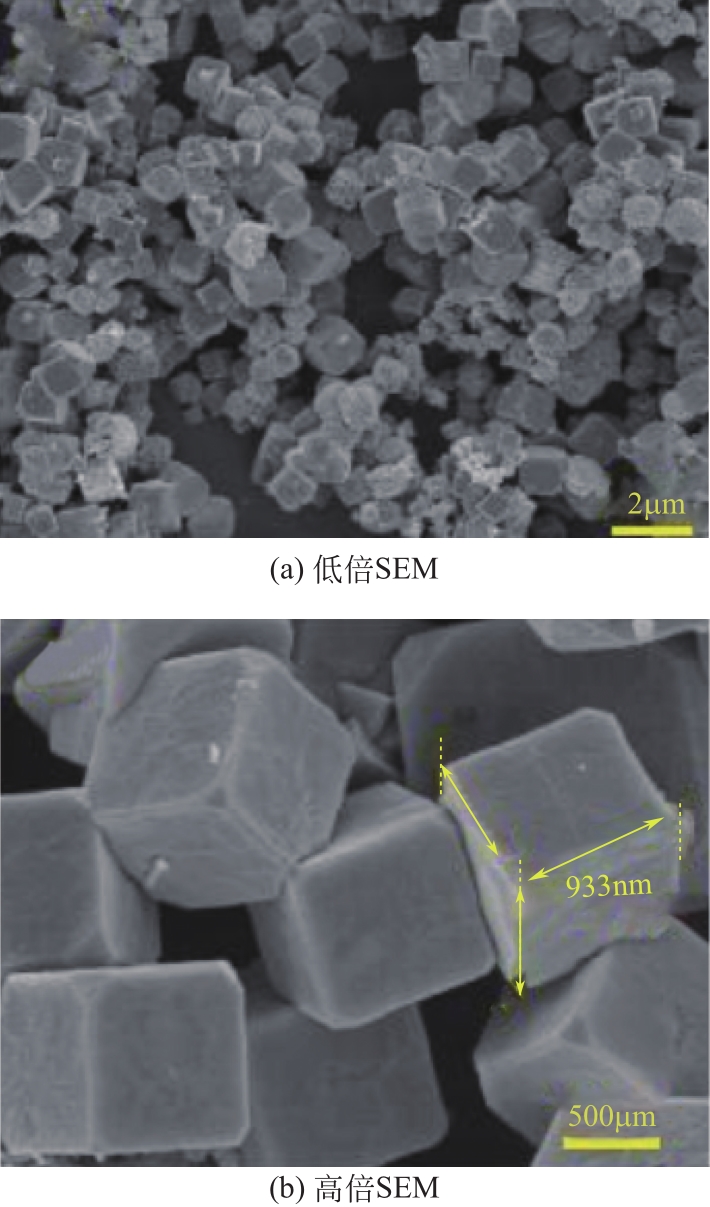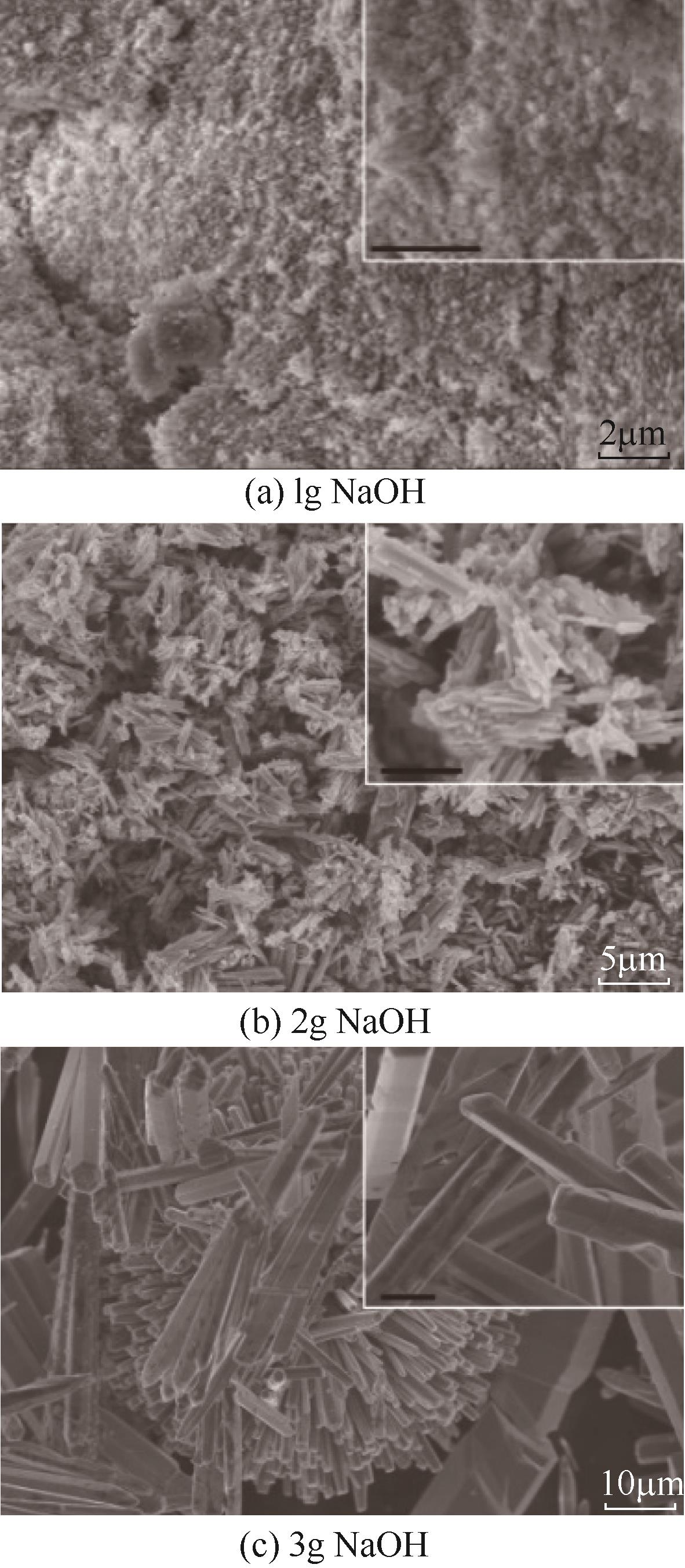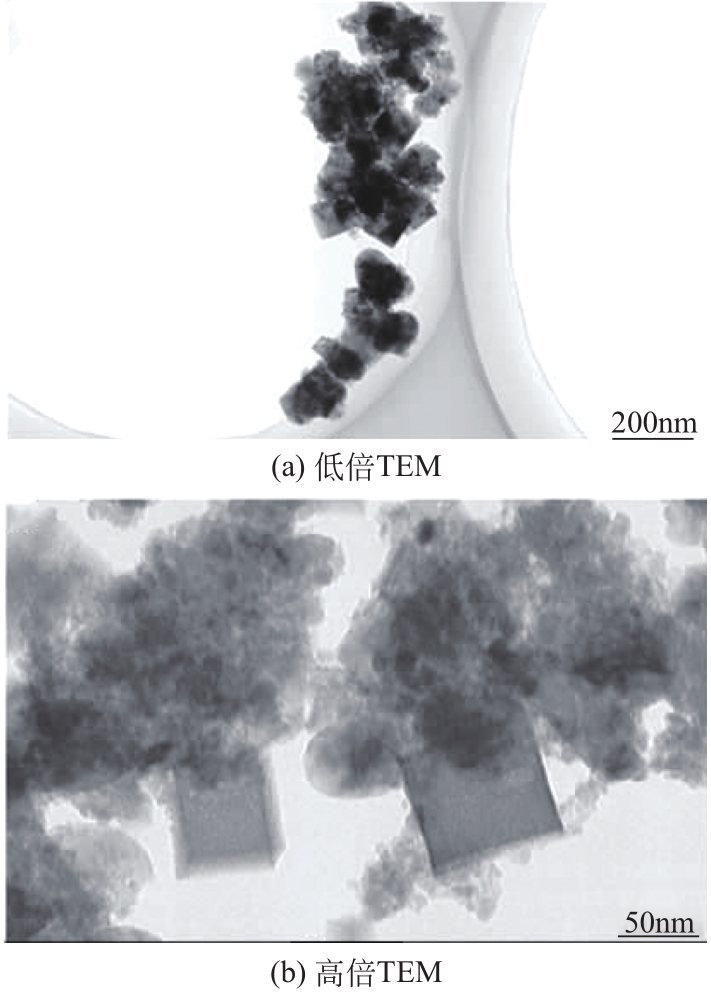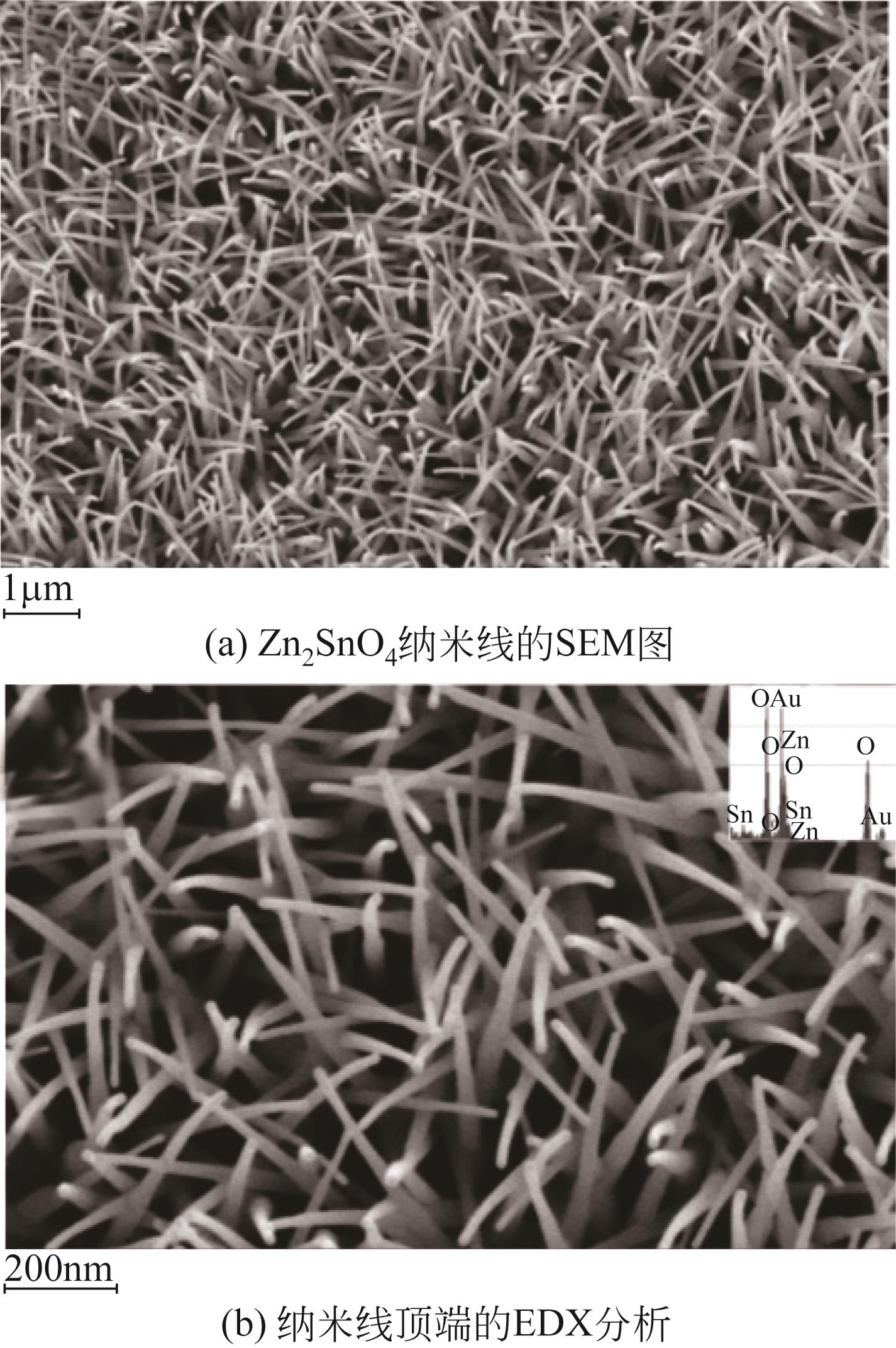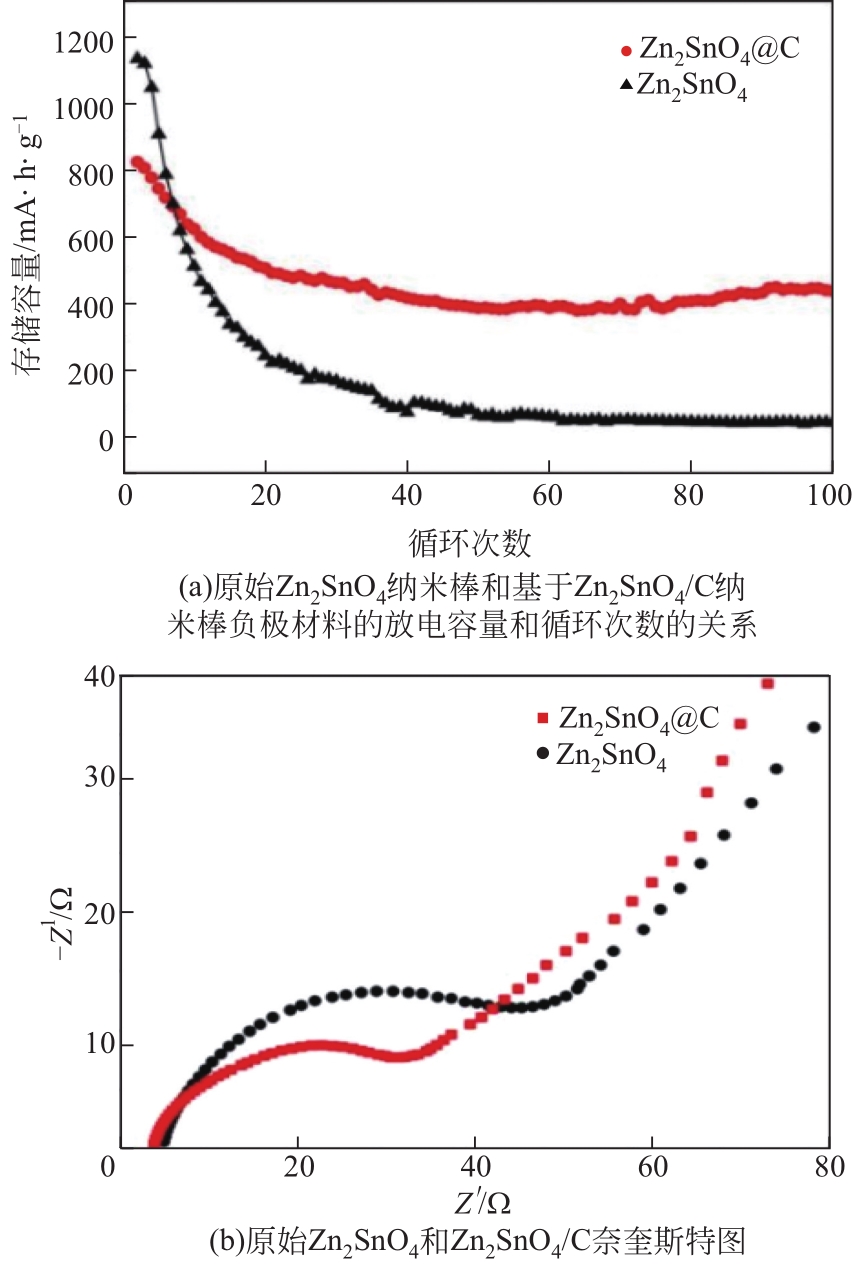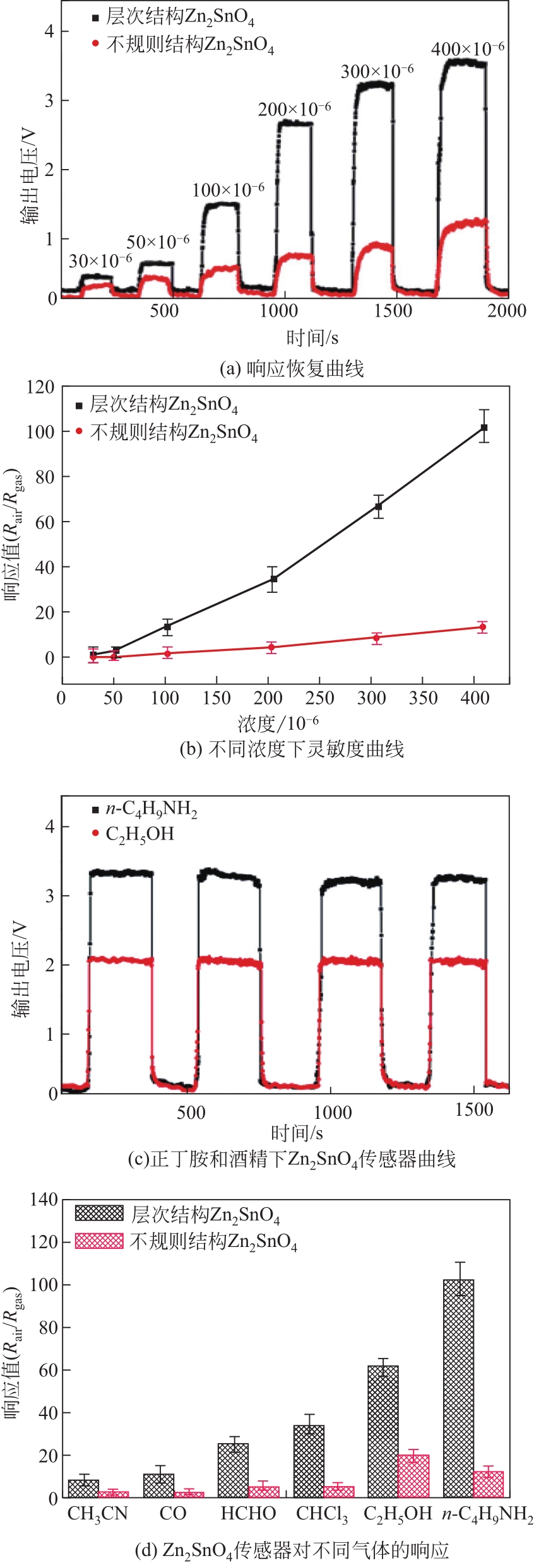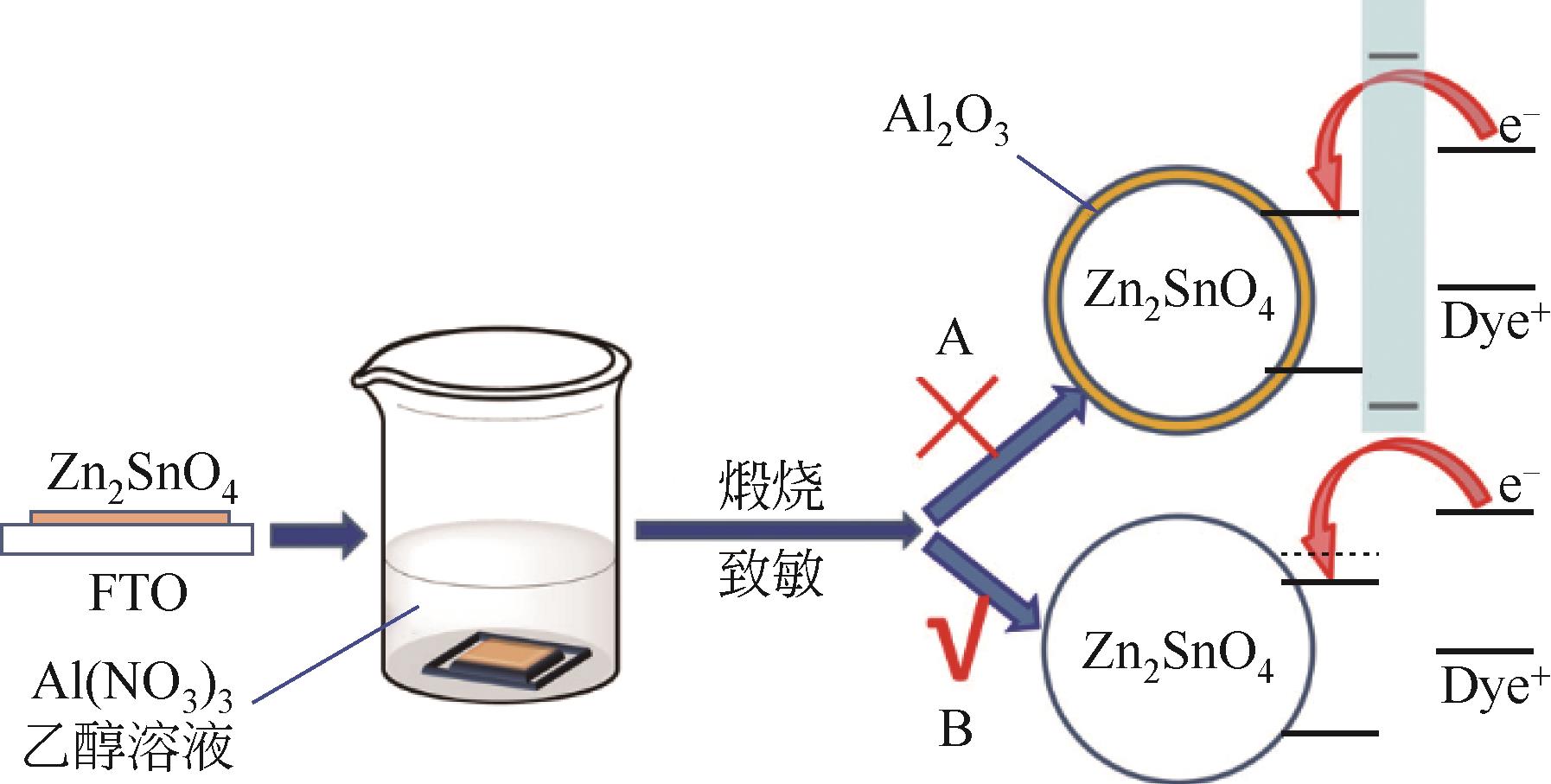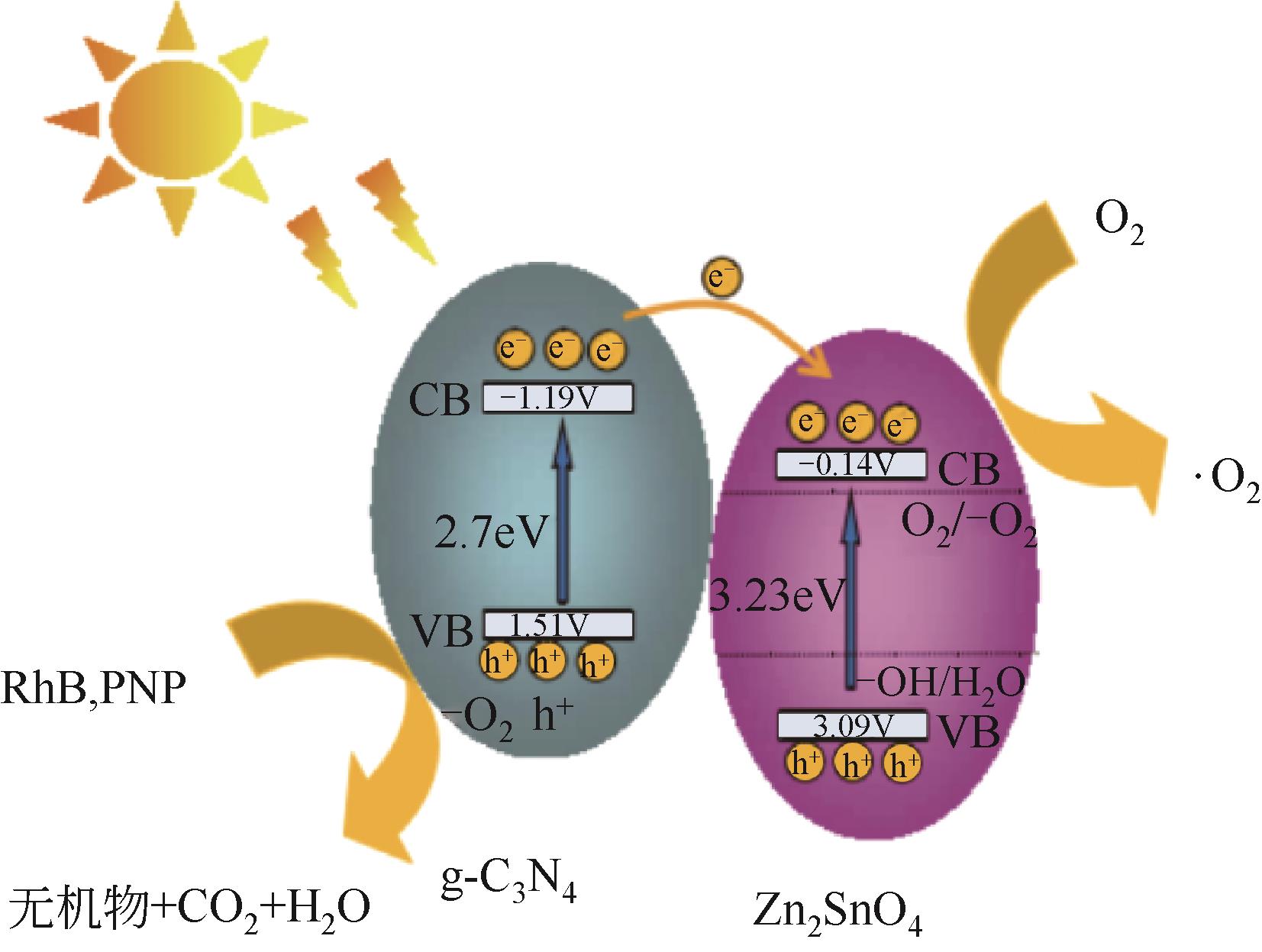化工进展 ›› 2022, Vol. 41 ›› Issue (6): 3113-3126.DOI: 10.16085/j.issn.1000-6613.2021-1595
锡酸锌纳米材料的制备方法及应用研究进展
马殿普( ), 李俊, 覃德清, 袁英杰, 潘飞, 符泽卫(
), 李俊, 覃德清, 袁英杰, 潘飞, 符泽卫( )
)
- 云南锡业集团(控股)有限责任公司研发中心,云南 昆明 650200
-
收稿日期:2021-07-27修回日期:2021-12-16出版日期:2022-06-10发布日期:2022-06-21 -
通讯作者:符泽卫 -
作者简介:马殿普(1991—),男,硕士,工程师,研究方向为无机锡粉体材料及锡基阻燃材料的制备。E-mail:madianpu@126.com 。 -
基金资助:云南省重大科技专项(202002AB080001);云南省“万人计划”产业技术领军人才专项(YNWR-CYJS-2017-056);云南省重大科技专项(202102AB080002)
Research progress on the preparation method and application of zinc stannate nanomaterials
MA Dianpu( ), LI Jun, QIN Deqing, YUAN Yingjie, PAN Fei, FU Zewei(
), LI Jun, QIN Deqing, YUAN Yingjie, PAN Fei, FU Zewei( )
)
- Yunnan Tin Industry Group (Holding) Company Limited R&D Center, Kunming 650200, Yunnan, China
-
Received:2021-07-27Revised:2021-12-16Online:2022-06-10Published:2022-06-21 -
Contact:FU Zewei
摘要:
锡酸锌由于具有较高的电子迁移率、稳定性、高电导率,优异的吸附性能、光学性能和阻燃抑烟性能等特性,近年来逐渐受到科研人员的关注。本文介绍了锡酸锌纳米颗粒的制备方法(水热法、化学沉淀法、固相化学合成法、微波合成法、溶胶-凝胶法、模板法等)、形貌结构(颗粒状、立方体、球形、八面体、纳米棒、片状、纳米花状等)、粒径及其在不同领域(锂电负极材料、气敏材料、电触头材料、DSSC阳极、光催化、阻燃等)的应用研究进展,分析了利用不同锡化合物原料、不同方法制备锡酸锌纳米颗粒的原理、制备条件和产品特性,指出了每种制备方法的优缺点及每种制备方法中不同结构的形成机理,以及不同结构是如何对Zn2SnO4相关性能产生影响的。文章指出如何高效可控制备特定形貌和晶粒尺寸的锡酸锌是锡酸锌纳米材料未来的发展方向。
中图分类号:
引用本文
马殿普, 李俊, 覃德清, 袁英杰, 潘飞, 符泽卫. 锡酸锌纳米材料的制备方法及应用研究进展[J]. 化工进展, 2022, 41(6): 3113-3126.
MA Dianpu, LI Jun, QIN Deqing, YUAN Yingjie, PAN Fei, FU Zewei. Research progress on the preparation method and application of zinc stannate nanomaterials[J]. Chemical Industry and Engineering Progress, 2022, 41(6): 3113-3126.
| 形貌 | 气体 | 工作温度/℃ | 气体浓度/10-6 | 灵敏度 | 响应恢复时间/s | 检测限/10-6 | 文献 |
|---|---|---|---|---|---|---|---|
| 空心八面体 | H2S | 260 | 50 | 46.0 | — | 1 | [ |
| 纳米立方体 | 正丁胺 | 350 | 400 | 102.2 | — | 30 | [ |
| 纳米薄膜 | NO2 | 200 | 200 | 2.66 | 25/326(200×10-6) | 50 | [ |
| 纳米花状 | LPG | 室温 | 5000 | 2.5 | 180/240(5000×10-6) | — | [ |
| 齿状纳米线 | 乙醇 | — | 200 | 27 | 7/8 | 1 | [ |
| 纳米粒子 | 乙醇 | 180 | 100 | 46.5 | — | 5 | [ |
| 纳米球 | 乙醇 | 180 | 50 | 23.4 | — | 5 | [ |
| 八面体 | TEA | 200 | 100 | 37 | 2/17(100×10-6) | 5 | [ |
| 空心立方体 | 丙酮 | 260 | 200 | 141.7 | — | 10 | [ |
| 空心球 | 丙酮 | 200 | 200 | 153 | 7/9(200×10-6) | 20 | [ |
表1 Zn2SnO4对不同气体的气敏性能
| 形貌 | 气体 | 工作温度/℃ | 气体浓度/10-6 | 灵敏度 | 响应恢复时间/s | 检测限/10-6 | 文献 |
|---|---|---|---|---|---|---|---|
| 空心八面体 | H2S | 260 | 50 | 46.0 | — | 1 | [ |
| 纳米立方体 | 正丁胺 | 350 | 400 | 102.2 | — | 30 | [ |
| 纳米薄膜 | NO2 | 200 | 200 | 2.66 | 25/326(200×10-6) | 50 | [ |
| 纳米花状 | LPG | 室温 | 5000 | 2.5 | 180/240(5000×10-6) | — | [ |
| 齿状纳米线 | 乙醇 | — | 200 | 27 | 7/8 | 1 | [ |
| 纳米粒子 | 乙醇 | 180 | 100 | 46.5 | — | 5 | [ |
| 纳米球 | 乙醇 | 180 | 50 | 23.4 | — | 5 | [ |
| 八面体 | TEA | 200 | 100 | 37 | 2/17(100×10-6) | 5 | [ |
| 空心立方体 | 丙酮 | 260 | 200 | 141.7 | — | 10 | [ |
| 空心球 | 丙酮 | 200 | 200 | 153 | 7/9(200×10-6) | 20 | [ |
| 材料 | 电阻率 /μΩ·cm-1 | 硬度HV /MPa | 理论密度 /g·cm-3 | 相对密度 /% |
|---|---|---|---|---|
| Ag/SnO2 | 2.61 | 804.0 | 9.89 | 95.40 |
| Ag/ZnO | 2.57 | 692.6 | 9.50 | 90.74 |
| Ag/Zn2SnO4 | 2.31 | 656.3 | 9.75 | 97.54 |
表2 不同增强相制得的Ag基电接触材料性能对比
| 材料 | 电阻率 /μΩ·cm-1 | 硬度HV /MPa | 理论密度 /g·cm-3 | 相对密度 /% |
|---|---|---|---|---|
| Ag/SnO2 | 2.61 | 804.0 | 9.89 | 95.40 |
| Ag/ZnO | 2.57 | 692.6 | 9.50 | 90.74 |
| Ag/Zn2SnO4 | 2.31 | 656.3 | 9.75 | 97.54 |
阻燃剂添加量 /份 | 极限氧指数 /% | 烟密度等级 /% | 最大烟密度等级 /% | 残炭率 /% |
|---|---|---|---|---|
| 0 | 28.7 | 90.5 | 100.0 | 20.8 |
| 5 | 33.1 | 88.3 | 95.7 | 23.4 |
| 10 | 34.9 | 85.8 | 93.7 | 26.7 |
| 15 | 36.0 | 86.2 | 93.2 | 29.7 |
| 20 | 36.4 | 86.4 | 94.5 | 29.4 |
表3 Zn2SnO4对软质 PVC阻燃消烟性能的影响
阻燃剂添加量 /份 | 极限氧指数 /% | 烟密度等级 /% | 最大烟密度等级 /% | 残炭率 /% |
|---|---|---|---|---|
| 0 | 28.7 | 90.5 | 100.0 | 20.8 |
| 5 | 33.1 | 88.3 | 95.7 | 23.4 |
| 10 | 34.9 | 85.8 | 93.7 | 26.7 |
| 15 | 36.0 | 86.2 | 93.2 | 29.7 |
| 20 | 36.4 | 86.4 | 94.5 | 29.4 |
| 1 | ANNAMALAI A, CARVALHO D, WILSON K C, et al. Properties of hydrothermally synthesized Zn2SnO4 nanoparticles using Na2CO3 as a novel mineralizer[J]. Materials Characterization, 2010, 61(9): 873-881. |
| 2 | ALPUCHE-AVILES M A, WU Y. Photoelectrochemical study of the band structure of Zn2SnO4 prepared by the hydrothermal method[J]. Journal of the American Chemical Society, 2009, 131(9): 3216-3224. |
| 3 | ZHU H, YANG D, YU G, et al. Hydrothermal synthesis of Zn2SnO4 nanorods in the diameter regime of sub-5 nm and their properties[J]. The Journal of Physical Chemistry B, 2006, 110(15): 7631-7634. |
| 4 | PAN Jun, XI Baojuan, ZHOU Hongyang, et al. Hydrothermal synthesis and photoluminescence of hollow octahedral Zn2SnO4 hierarchical structures[J]. Chinese Journal of Inorganic Chemistry, 2010, 26(6): 939-945. |
| 5 | 曾毅, 邴一飞, 刘畅, 等. Zn2SnO4立方体的水热合成及其荧光性质[J]. 发光学报, 2012, 33(7): 716-719. |
| ZENG Yi, BING Yifei, LIU Chang, et al. Hydrothermal synthesis and PL properties of Zn2SnO4 nanocubes[J]. Chinese Journal of Luminescence, 2012, 33(7): 716-719. | |
| 6 | FAN W, LIU X, WANG Z, et al. Synergetic enhancement of the electronic/ionic conductivity of a Li-ion battery by fabrication of a carbon-coated nanoporous SnO x Sb alloy anode[J]. Nanoscale, 2018, 10(16): 7605-7611. |
| 7 | KIM A Y, ARDHI R E A, LIU G C, et al. Hierarchical hollow dual core-shell carbon nanowall-encapsulated p-n SnO/SnO2 heterostructured anode for high-performance lithium-ion-based energy storage[J]. Carbon, 2019, 153: 62-72. |
| 8 | XIA J, GUO Y P, TIAN R, et al. 3D composites of ZnSnO3 nanoplates/reduced graphene oxide aerogels as an advanced lithium-ion battery anode[J]. Journal of Materials Science: Materials in Electronics, 2018, 29(7): 5299-5306. |
| 9 | 马殿普, 李俊, 潘飞, 等. 溴-锑-锡复配型阻燃剂协同阻燃聚丙烯性能研究[J]. 塑料工业, 2021, 49(10): 120-125. |
| MA Dianpu, LI Jun, PAN Fei, et al. Study on the performance of synergistic flame retardant polypropylene with bromine-antimony-tin compound flame retardant[J]. China Plastics Industry, 2021, 49(10): 120-125. | |
| 10 | 李杰康,谢吉星. 机械力化学制备锡酸锌及其在PVC中的阻燃应用[J]. 无机盐工业, 2019, 1(5): 33-37. |
| LI J K, XIE J X. Mechano-chemical preparation of zinc stannate and its flame-retardant application in PVC[J]. Inorganic Chemicals Industry, 2019, 51(5):33-37. | |
| 11 | SANTHOSHKUMAR P, PRASANNA K, JO Y N, et al. Synthesis of highly crystalline octahedron 3D-Zn2SnO4 as an advanced high-performance anode material for lithium ion batteries[J]. Applied Surface Science, 2018, 449: 514-520. |
| 12 | LIANG J J, YUAN C C, LI H H, et al. Growth of SnO2 nanoflowers on N-doped carbon nanofibers as anode for Li- and Na-ion batteries[J]. Nano-Micro Letters, 2017, 10(2): 1-9. |
| 13 | KIM N, SHIM J H, JAE W, et al. Zn2SnO4 particles coated with N-doped carbon as an anode material for lithium and sodium-ion batteries[J]. Journal of Alloys and Compounds, 2019, 786: 346-355. |
| 14 | XIA J, TIAN R, GUO Y P, et al. Zn2SnO4-carbon cloth freestanding flexible anodes for high-performance lithium-ion batteries[J]. Materials & Design, 2018, 156: 272-277. |
| 15 | ALI M B, HAMDI A, ELHOUICHET H, et al. High photocatalytic activity of plasmonic Ag@AgCl/Zn2SnO4 nanocomposites synthesized using hydrothermal method[J]. RSC Advances, 2016, 6(83): 80310-80319. |
| 16 | BARUAH S, DUTTA J. Zinc stannate nanostructures: hydrothermal synthesis[J]. Science and Technology of Advanced Materials, 2011, 12(1): 013004. |
| 17 | HOLLOWAY P C, ETSELL T H, MURLAND A L. Roasting of La oroya zinc ferrite with Na2CO3 [J]. Metallurgical and Materials Transactions B, 2007, 38(5): 781-791. |
| 18 | 夏季. 锡酸锌/碳材料复合物锂离子电池负极材料的制备及性能研究[D]. 上海: 上海交通大学, 2018. |
| XIA Ji. Preparation and properties of zinc stannate and carbon materials composites for anode materials for lithium ion batteries[D]. Shanghai: Shanghai Jiaotong University, 2018. | |
| 19 | 方军, 黄爱红. 正八面体锡酸锌的水热合成[J]. 无机盐工业, 2013, 45(6): 30-32. |
| FANG Jun, HUANG Aihong. Hydrothermal synthesis of octahedra Zn2SnO4 [J]. Inorganic Chemicals Industry, 2013, 45(6): 30-32. | |
| 20 | CHEN Z, CAO M H, HU C W. Novel Zn2SnO4 hierarchical nanostructures and their gas sensing properties toward ethanol[J]. The Journal of Physical Chemistry C, 2011, 115(13): 5522-5529. |
| 21 | ZHU X J, GENG L M, ZHANG F Q, et al. Synthesis and performance of Zn2SnO4 as anode materials for lithium ion batteries by hydrothermal method[J]. Journal of Power Sources, 2009, 189(1): 828-831. |
| 22 | 王欣, 邓建华. Zn2SnO4负极材料的制备及其电化学性能[J]. 天津师范大学学报(自然科学版), 2021, 41(1): 24-28. |
| WANG Xin, DENG Jianhua. Preparation and electrochemical performance of Zn2SnO4 anode materials[J]. Journal of Tianjin Normal University (Natural Science Edition), 2021, 41(1): 24-28. | |
| 23 | 胡伟东, 吴静, 焦运红, 等. 以碳球为模板制备空心结构锡酸锌及其在PVC中的阻燃应用[J]. 中国塑料, 2018, 32(1): 108-113. |
| HU Weidong, WU Jing, JIAO Yunhong, et al. Preparation of hollow-structure zinc stannate using carbon spheres as template and its application in flame-retardant PVC[J]. China Plastics, 2018, 32(1): 108-113. | |
| 24 | 叶晨琳, 张玲洁, 沈涛, 等. 锡酸锌纳米粉体的制备及其在电接触材料中的应用[J]. 稀有金属材料与工程, 2020, 49(4): 1288-1294. |
| YE Chenlin, ZHANG Lingjie, SHEN Tao, et al. Preparation of cubic zinc stannate nanopowder and its application in silver-based electrical contact material[J]. Rare Metal Materials and Engineering, 2020, 49(4): 1288-1294. | |
| 25 | 郑秀君, 李锦州, 肖雪, 等. 尖晶石型锡酸锌光催化降解二甲酚橙的性能[J]. 黑龙江工程学院学报(自然科学版), 2011, 25(4): 45-48. |
| ZHENG X J, LI J Z, XIAO X, et al. Photocatalytic performance for xylenol orange of spinel type zinc stannate[J]. Journal of Heilongjiang Institute of Technology (Natural Science Edition), 2011, 25(4):45-48. | |
| 26 | STAMBOLOVA I, TONEVA A, BLASKOV V, et al. Preparation of nanosized spinel stannate, Zn2SnO4, from a hydroxide precursor[J]. Journal of Alloys and Compounds, 2005, 391(1/2): L1-L4. |
| 27 | 刘凤敏, 钟铁钢, 梁喜双, 等. Zn2SnO4气敏材料的共沉淀法制备及其氧化物掺杂改性[J]. 仪表技术与传感器, 2009(S1): 105-106. |
| LIU Fengmin, ZHONG Teigang, LIANG Xishuang, et al. Zn2SnO4 gas-sensing materials prepared by coprecipitation and doped oxides[J]. Instrument Technique and Sensor, 2009(S1): 105-106. | |
| 28 | 何汉兵, 秦毅红, 石西昌, 等. 阻燃剂锡酸锌的优化制备[J]. 化学工程, 2006, 34(5): 65-67. |
| HE Hanbing, QIN Yihong, SHI Xichang, et al. Study on the optimization of blockburning substance——zinc stannate[J]. Chemical Engineering, 2006, 34(5): 65-67. | |
| 29 | WANG S M, YANG Z S, LU M K, et al. Coprecipitation synthesis of hollow Zn2SnO4 spheres[J]. Materials Letters, 2007, 61(14/15): 3005-3008. |
| 30 | 徐甲强, 刘艳丽, 牛新书. ZnSnO3纳米粉体的合成及其气敏特性研究[J]. 硅酸盐学报, 2002, 30(3): 321-324. |
| XU Jiaqiang, LIU Yanli, NIU Xinshu. Preparation and gas sensitivity of nanosized ZnSnO3 [J]. Journal of the Chinese Ceramic Society, 2002, 30(3): 321-324. | |
| 31 | 王中长, 刘天模, 余龙, 等. 高纯纳米ZnSnO3气敏材料的制备及气敏性能[J]. 硅酸盐学报, 2004, 32(12): 1555-1559. |
| WANG Zhongchang, LIU Tianmo, YU Long, et al. Preparation and properties of ultra-purity and nanosized ZnSnO3 gas sensitive material[J]. Journal of the Chinese Ceramic Society, 2004, 32(12): 1555-1559. | |
| 32 | PARTHIBAVARMAN M, VALLALPERUMAN K, SEKAR C, et al. Retracted: microwave synthesis, characterization and humidity sensing properties of single crystalline Zn2SnO4 nanorods[J]. Vacuum, 2012, 86(10): 1488-1493. |
| 33 | ZHANG D, ZHANG Y Q, FAN Y, et al. Micro-spherical ZnSnO3 material prepared by microwave-assisted method and its ethanol sensing properties[J]. Chinese Chemical Letters, 2020, 31(8): 2087-2090. |
| 34 | WANG Y K, LI D, LIU Y S, et al. Fabrication of novel rugby-like ZnSnO3/reduced graphene oxide composites as a high-performance anode material for lithium-ion batteries[J]. Materials Letters, 2016, 167: 222-225. |
| 35 | 黄保军, 何琴, 刘焕丽, 等. 微纳米锡酸锌的仿生合成与表征[J]. 石化技术与应用, 2012, 30(1): 27-30. |
| HUANG Baojun, HE Qin, LIU Huanli, et al. Biomimetic synthesis and characterization of zinc stannate with micro/nano structures[J]. Petrochemical Technology & Application, 2012, 30(1): 27-30. | |
| 36 | 陈灵智, 杨佳辉, 吴瑞红, 等. 模板合成AC-Zn2SnO4对PVC热降解性能影响[J]. 现代塑料加工应用, 2021, 33(1): 14-18. |
| CHEN Lingzhi, YANG Jiahui, WU Ruihong, et al. Effect of AC-Zn2SnO4 synthesized by template on thermal degradation of PVC[J]. Modern Plastics Processing and Applications, 2021, 33(1): 14-18. | |
| 37 | 唐香珺, 李俊寿, 赵芳, 等. 锡酸锌微纳米材料的合成及其反应机理[J]. 陶瓷学报, 2020, 41(1): 121-126. |
| TANG Xiangjun, LI Junshou, ZHAO Fang, et al. Synthesis and reaction mechanism of Zn2SnO4 micro and nano materials[J]. Journal of Ceramics, 2020, 41(1): 121-126. | |
| 38 | 刘中奎. 秧苗状Zn2SnO4纳米线的制备及光致发光性能研究[J]. 光散射学报, 2011, 23(3): 234-237. |
| LIU Zhongkui. Synthesis and photoluminescence of seedling-like Zn2SnO4 nanowires[J]. The Journal of Light Scattering, 2011, 23(3): 234-237. | |
| 39 | RONG A, GAO X P, LI G R, et al. Hydrothermal synthesis of Zn2SnO4 as anode materials for Li-ion battery[J]. The Journal of Physical Chemistry B, 2006, 110(30): 14754-14760. |
| 40 | YUAN W S, TIAN Y W, LIU G Q. Synthesis and electrochemical properties of pure phase Zn2SnO4 and composite Zn2SnO4/C[J]. Journal of Alloys and Compounds, 2010, 506(2): 683-687. |
| 41 | JIANG T T, TIAN X H, GU H Z, et al. Zn2SnO4@C core-shell nanorods with enhanced anodic performance for lithium-ion batteries[J]. Journal of Alloys and Compounds, 2015, 639: 239-243. |
| 42 | WANG K, HUANG Y, HUANG H J, et al. Hydrothermal synthesis of flower-like Zn2SnO4 composites and their performance as anode materials for lithium-ion batteries[J]. Ceramics International, 2014, 40(6): 8021-8025. |
| 43 | MA G X, ZOU R J, JIANG L, et al. Phase-controlled synthesis and gas-sensing properties of zinc stannate (ZnSnO3 and Zn2SnO4) faceted solid and hollow microcrystals[J]. CrystEngComm, 2012, 14(6): 2172. |
| 44 | JIANG Y Q, HE C X, SUN R, et al. Synthesis of Zn2SnO4 nanoplate-built hierarchical cube-like structures with enhanced gas-sensing property[J]. Materials Chemistry and Physics, 2012, 136(2/3): 698-704. |
| 45 | 叶晨琳. 纳米锡酸锌制备及其在银基电接触材料中的应用研究[D]. 杭州: 浙江大学, 2019. |
| YE Chenlin. Preparation of Zn2SnO4 nanopowder and its application in silver-based electrical contact material[D]. Hangzhou: Zhejiang University, 2019. | |
| 46 | 隋晓涵. ZTO/Ag电触头材料的设计与制备[D]. 哈尔滨: 哈尔滨工业大学, 2020. |
| SUI Xiaohan. Design and preparation of ZTO/Ag electrical contact materials[D]. Harbin: Harbin Institute of Technology, 2020. | |
| 47 | TAN B, TOMAN E, LI Y G, et al. Zinc stannate (Zn2SnO4) dye-sensitized solar cells[J]. Journal of the American Chemical Society, 2007, 129(14): 4162-4163. |
| 48 | AL-ATTAFI K, JAWDAT F H, QUTAISH H, et al. Cubic aggregates of Zn2SnO4 nanoparticles and their application in dye-sensitized solar cells[J]. Nano Energy, 2019, 57: 202-213. |
| 49 | CHEN J J, LU L Y, WANG W Y. Zn2SnO4 nanowires as photoanode for dye-sensitized solar cells and the improvement on open-circuit voltage[J]. The Journal of Physical Chemistry C, 2012, 116(20): 10841-10847. |
| 50 | LI Z D, ZHOU Y, MAO W T, et al. Nanowire-based hierarchical tin oxide/zinc stannate hollow microspheres: enhanced solar energy utilization efficiency for dye-sensitized solar cells and photocatalytic degradation of dyes[J]. Journal of Power Sources, 2015, 274: 575-581. |
| 51 | WANG K, SHI Y T, GUO W, et al. Zn2SnO4-based dye-sensitized solar cells: insight into dye-selectivity and photoelectric behaviors[J]. Electrochimica Acta, 2014, 135: 242-248. |
| 52 | LI Y F, ZHENG X Z, ZHANG H X, et al. Improving the efficiency of dye-sensitized Zn2SnO4 solar cells: the role of Al3+ ions[J]. Electrochimica Acta, 2011, 56(25): 9257-9261. |
| 53 | SEYED DORRAJI M S, AMANI-GHADIM A R, RASOULIFARD M H, et al. The role of carbon nanotube in zinc stannate photocatalytic performance improvement: experimental and kinetic evidences[J]. Applied Catalysis B: Environmental, 2017, 205: 559-568. |
| 54 | 赵春美. 半导体纳米复合材料的制备及光催化性能的研究[D]. 长春: 长春理工大学, 2017. |
| ZHAO Chunmei. Preparation and photocatalytic performances of semiconductor nanocomposites[D]. Changchun: Changchun University of Science and Technology, 2017. | |
| 55 | 陈强, 郑楠, 安佳乐, 等. 不同形貌羟基锡酸锌的制备及其光催化性能[J]. 大连工业大学学报, 2020, 39(4): 276-280. |
| CHEN Qiang, ZHENG Nan, AN Jiale, et al. Preparation and photocatalytic properties of zinc hydroxystannate with various morphologies[J]. Journal of Dalian Polytechnic University, 2020, 39(4): 276-280. | |
| 56 | 袁英杰, 张家涛, 彭巨擘, 等. 羟基锡酸锌/锡酸锌的阻燃应用与研究进展[J]. 现代塑料加工应用, 2019, 31(3): 60-63. |
| YUAN Yingjie, ZHANG Jiatao, PENG Jubo, et al. Flame retardant application and research progress of zinc hydroxystannate/zinc stannate[J]. Modern Plastics Processing and Applications, 2019, 31(3): 60-63. | |
| 57 | 马殿普, 李俊, 彭巨擘, 等. 阻燃抑烟剂锡酸锌和羟基锡酸锌改性技术研究进展[J]. 塑料工业, 2020, 48(11): 20-26. |
| MA Dianpu, LI Jun, PENG Jubo, et al. Research progress of modification technology of zinc stannate and zinc hydroxystannateas flame retardant and smoke suppression agents[J]. China Plastics Industry, 2020, 48(11): 20-26. | |
| 58 | 徐建中, 封小洁, 陈灵智, 等. Zn2SnO4的制备及其对软质聚氯乙烯的阻燃研究[J]. 中国塑料, 2013, 27(10): 52-57. |
| XU Jianzhong, FENG Xiaojie, CHEN Lingzhi, et al. Preparation of Zn2SnO4 and its flame retardant effect on flexible poly(vinyl chloride)[J]. China Plastics, 2013, 27(10): 52-57. | |
| 59 | 徐建中, 刘军坡, 焦运红, 等. 锡酸锌协效阻燃聚丙烯[J]. 塑料, 2014, 43(6): 65-68. |
| XU Jianzhong, LIU Junpo, JIAO Yunhong, et al. Synergistic effect of zinc stannate on flame retardant PP[J]. Plastics, 2014, 43(6): 65-68. | |
| 60 | HORROCKS A R, SMART G, KANDOLA B, et al. Zinc stannate interactions with flame retardants in polyamides; Part 2: potential synergies with non-halogen-containing flame retardants in polyamide 6 (PA6)[J]. Polymer Degradation and Stability, 2012, 97(4): 645-652. |
| 61 | 焦运红, 陈金杰, 吴静, 等. 两种形貌的羟基锡酸锌对聚氯乙烯的阻燃作用[J]. 中国塑料, 2016, 30(12): 75-80. |
| JIAO Yunhong, CHEN Jinjie, WU Jing, et al. Flame retardant effect of two kinds of zinc hydroxystannate on poly(vinyl chloride)[J]. China Plastics, 2016, 30(12): 75-80. |
| [1] | 杨莹, 侯豪杰, 黄瑞, 崔煜, 王兵, 刘健, 鲍卫仁, 常丽萍, 王建成, 韩丽娜. 利用煤焦油中酚类物质Stöber法制备碳纳米球用于CO2吸附[J]. 化工进展, 2023, 42(9): 5011-5018. |
| [2] | 尹新宇, 皮丕辉, 文秀芳, 钱宇. 特殊浸润性材料在防治油气管道中水合物成核与聚集的应用[J]. 化工进展, 2023, 42(8): 4076-4092. |
| [3] | 毛善俊, 王哲, 王勇. 基团辨识加氢:从概念到应用[J]. 化工进展, 2023, 42(8): 3917-3922. |
| [4] | 吴亚, 赵丹, 方荣苗, 李婧瑶, 常娜娜, 杜春保, 王文珍, 史俊. 用于复杂原油乳液的高效破乳剂开发及应用研究进展[J]. 化工进展, 2023, 42(8): 4398-4413. |
| [5] | 徐沛瑶, 陈标奇, KANKALA Ranjith Kumar, 王士斌, 陈爱政. 纳米材料用于铁死亡联合治疗的研究进展[J]. 化工进展, 2023, 42(7): 3684-3694. |
| [6] | 孙旭东, 赵玉莹, 李诗睿, 王琦, 李晓健, 张博. 我国地方性氢能发展政策的文本量化分析[J]. 化工进展, 2023, 42(7): 3478-3488. |
| [7] | 许春树, 姚庆达, 梁永贤, 周华龙. 氧化石墨烯/碳纳米管对几种典型高分子材料的性能影响[J]. 化工进展, 2023, 42(6): 3012-3028. |
| [8] | 徐国彬, 刘洪豪, 李洁, 郭家奇, 王琪. ZnO量子点水性喷墨荧光墨水制备及性能[J]. 化工进展, 2023, 42(6): 3114-3122. |
| [9] | 金涌, 程易, 白丁荣, 张晨曦, 魏飞. 中国流态化技术研发史略[J]. 化工进展, 2023, 42(6): 2761-2780. |
| [10] | 陈怡欣, 甄摇摇, 陈瑞浩, 吴继伟, 潘丽美, 姚翀, 罗杰, 卢春山, 丰枫, 王清涛, 张群峰, 李小年. 铂基纳米催化剂的制备及在加氢领域的进展[J]. 化工进展, 2023, 42(6): 2904-2915. |
| [11] | 张晨宇, 王宁, 徐洪涛, 罗祝清. 纳米颗粒强化传热的多级潜热储热器性能评价[J]. 化工进展, 2023, 42(5): 2332-2342. |
| [12] | 陈少华, 王义华, 胡强飞, 胡坤, 陈立爱, 李洁. 电化学修饰电极在检测Cr(Ⅵ)中的研究进展[J]. 化工进展, 2023, 42(5): 2429-2438. |
| [13] | 殷铭, 郭晋, 庞纪峰, 吴鹏飞, 郑明远. 铜催化剂在涉氢反应中的失活机制和稳定策略[J]. 化工进展, 2023, 42(4): 1860-1868. |
| [14] | 葛伟童, 廖亚龙, 李明原, 嵇广雄, 郗家俊. Pd-Fe/MWCNTs双金属催化剂制备及其脱氯动力学[J]. 化工进展, 2023, 42(4): 1885-1894. |
| [15] | 万茂华, 张小红, 安兴业, 龙垠荧, 刘利琴, 管敏, 程正柏, 曹海兵, 刘洪斌. MXene在生物质基储能纳米材料领域中的应用研究进展[J]. 化工进展, 2023, 42(4): 1944-1960. |
| 阅读次数 | ||||||
|
全文 |
|
|||||
|
摘要 |
|
|||||
